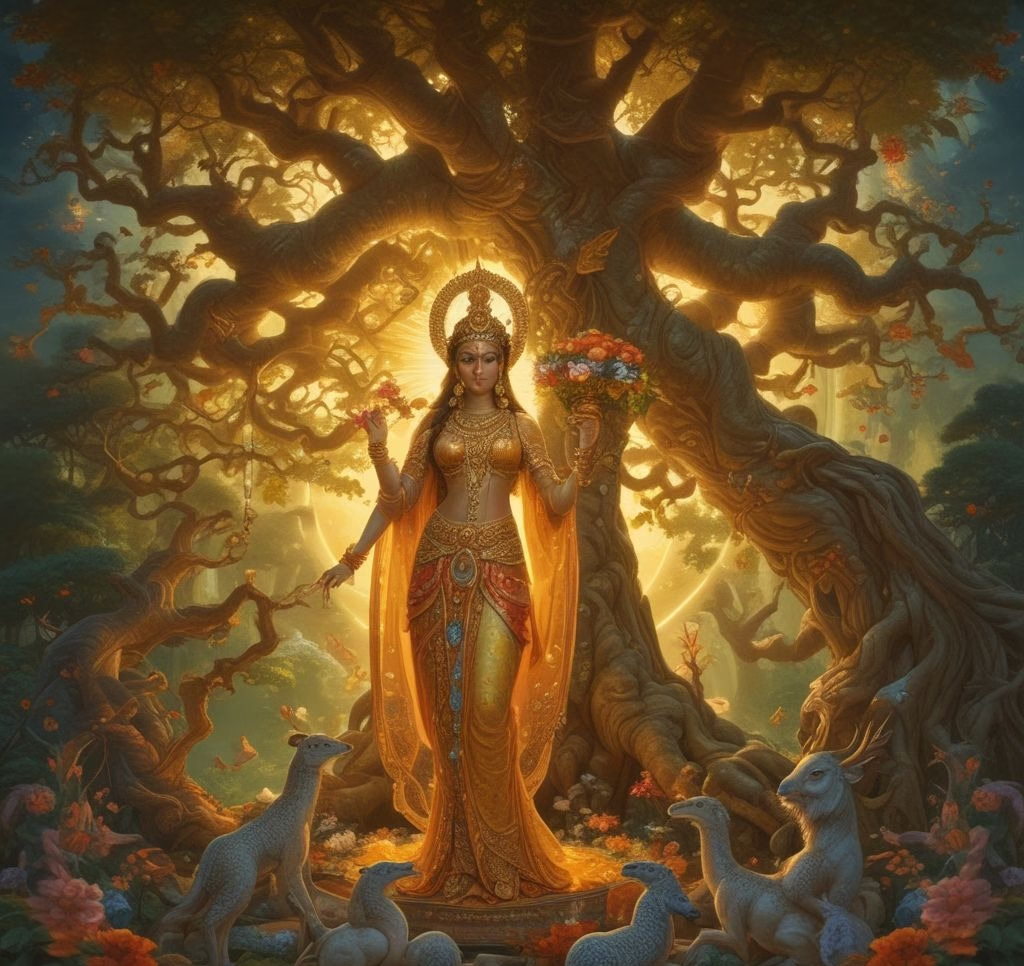The Tale of Aranyani: The Mysterious Goddess of Forests
In the vast and ancient cosmos of Hindu mythology, where countless deities embody cosmic forces and natural phenomena, one goddess remains surrounded by quiet mystery and sylvan depth — Aranyani, the enigmatic goddess of forests and wilderness. She is the divine spirit of the forest, a being who thrives where civilization yields to nature’s unbounded beauty. Unlike deities worshipped in glittering temples or urban shrines, Aranyani’s temple is the untouched forest itself — its whispering trees, rustling leaves, and hidden creatures.
Though her name is not frequently invoked in mainstream rituals today, her presence continues to breathe life into the wind-touched groves and verdant sanctuaries of India. Emerging from the Rigveda, among the world’s oldest known scriptures, Aranyani represents the sacred bond between humanity and the environment — a timeless reminder that nature is not a resource to exploit but a living divinity to revere.
The Divine Meaning of Her Name
Aranyani derives her name from the Sanskrit word Aranya, meaning “forest” or “wilderness.” The suffix -ni forms a feminine essence, giving us the meaning “She of the Forest” — the goddess who dwells within the green heart of the earth. In this definition lies the spiritual philosophy of eco-consciousness, deeply embedded in Vedic thought: nature as the ultimate teacher, provider, and mother.
Aranyani’s spirit does not merely inhabit the forest; she is the forest itself — its fragrance, motion, and vitality. Every rustling leaf, chirping bird, and gurgling stream becomes her voice. Through her, ancient Vedic civilization recognized the sanctity of ecological balance and harmony.
The Goddess of Wilderness and Vital Energy
Aranyani is revered as the Prana — or life force — of the forest. She nurtures the plants, protects wildlife, and sustains the intricate web of life that thrives beneath the forest canopy. In ancient times, villagers left offerings of grains or flowers at the boundary of woodlands to seek her blessings before harvesting or entering the forest. These rituals symbolized not just devotion but mutual respect between humanity and the ecosystem that nourishes it.
Described as a being radiant with natural grace, Aranyani’s divine aura is said to fill the forest with abundance. Even the Rigveda acknowledges her as “the one who tills no land but feeds all living creatures.” This poetic imagery captures her role as the invisible provider of sustenance and harmony.
The Elusive, Dancing Spirit of the Woods
Aranyani’s beauty lies in her elusiveness. Though rarely seen, she makes her presence known through sensory poetry — the gentle chiming of bells on her anklets as she dances between shadowed glades, the whispering breeze that brushes against leaves, or the sudden stillness that halts the woods when she listens. According to Vedic hymns, her unseen dance represents the rhythms of nature — unpredictable, eternal, and awe-inspiring.
The Aranyani Suktam (Hymn 146 in the Tenth Mandala of the Rigveda) is one of the oldest and most descriptive hymns dedicated to her. It portrays her as fearless, dwelling deep within remote places, unafraid of solitude, radiant with peace and mystery. Her independence from material needs makes her a symbol of both self-sufficiency and divine femininity — a spirit at once nurturing and wild.
The Origin Story: A Divine Birth of Balance
According to later Puranic and folk interpretations, Aranyani was born from the wish of Goddess Parvati and Lord Shiva beneath the Kalpavriksha — the celestial wish-fulfilling tree. When Parvati prayed for a daughter embodying purity, peace, prosperity, patience, and knowledge, her prayer was fulfilled through Shiva’s divine breath. From the sacred tree emerged a radiant maiden — Aranyani — her golden hair shimmering like sunlit leaves, her skin whiter than snow, symbolizing purity and balance. She was thus created to guard the forests of the earth and all the beings within.
This legend beautifully integrates cosmic harmony — where divinity manifests not in celestial palaces but within nature’s heart, where silence and vitality coexist.
Aranyani in the Rigveda: The Sacred Hymn of Nature
The Rigveda, a cornerstone of Hindu philosophical thought, immortalizes Aranyani as the wild goddess who lives in balance — serene yet powerful, yielding yet infinite. The hymns devoted to her reveal a communion between early human civilization and the natural world. Verse 10.146 describes her independence: though she “wanders far from the village edges,” she feels no loneliness. Her fearlessness within the unknown wilderness mirrors the eternal human quest to embrace rather than conquer nature.
This portrayal is deeply symbolic — Aranyani reflects the dualism of serenity and strength that nature embodies. She nourishes, yet she can also destroy imbalance. Through her, the ancient seers acknowledged that reverence for the forest was central to both survival and spiritual growth.
A Symbol of Ecological consciousness
Aranyani’s mythology transcends the boundaries of ancient hymns to deliver a timeless message: ecological harmony is sacred duty. At a time when the modern world grapples with deforestation, pollution, and environmental decline, her narrative holds urgent relevance. She teaches that the forest is not humanity’s servant but its equal — a breathing embodiment of divine existence.
In many regions of India, remnants of her worship survive in local deities like Banbibi of the Sundarbans or Vanadurga of South India, both protectors of wilderness and balance. Their veneration preserves, in folk form, the ancient reverence for natural sanctuaries that Aranyani once represented in Vedic tradition.
Modern environmental movements in India often draw from such spiritual symbols to rekindle ecological awareness. The concept of Aranya Samskriti (Culture of the Forest) espoused by hermits and sages in ancient Vedanta viewed forests not as primitive spaces but as models for sustainable, self-sufficient living — an idea that mirrors environmental philosophy today.
The Feminine Energy of the Forest
In Vedic symbolism, forests are feminine spaces — fertile, nurturing, and endlessly rejuvenating. Aranyani personifies Shakti, the divine feminine energy that sustains the natural cycles of creation and dissolution. Her form represents the maternal aspects of nature — giving shelter, food, and protection — yet also the fierce, protective aspect when balance is threatened.
Her silent dance among trees becomes an allegory of coexistence: the forest thrives when every root, leaf, insect, and animal performs its role in perfect rhythm, mirroring the cosmic dance of creation known as Tandava, often associated with Lord Shiva.
By embodying this feminine principle, Aranyani becomes not just a guardian of forests but also an archetype of harmony — teaching that nurturing strength is the essence of true power.
The Decline of Her Worship and the Seeds of Revival
Over centuries, with the rise of urban civilization and temple-based traditions, the cult of Aranyani slowly faded. Few temples remain — one being the Aranya Devi Temple in Arrah, Bihar — but her spirit continues to live in folk tales and rural rituals offered to nature spirits. Unlike gods associated with kingdoms or households, Aranyani’s domain lies beyond human ownership, making her worship inherently free, untamed, and universal.
Today, devotees and environmental activists invoke her symbolism during forest conservation drives, tree-planting rituals, and Earth festivals. The International Day of Forests, for instance, often draws upon her mythology as a cultural narrative to inspire ecological responsibility, reminding humanity of its sacred duty as caretakers of the Earth.
Cultural and Global Resonance
In contemporary culture, Aranyani has re-emerged as a symbol of spiritual ecology — blending myth, art, and environmentalism. Literature, artwork, and even fashion collections have rediscovered her as an icon of balance between human ambition and ecological wisdom. She features in modern storytelling as both muse and moral guide — an embodiment of sustainability, beauty, and mystery.
Across artistic movements, she inspires representations of divine femininity intertwined with nature. Her imagery — a woman clad in leaves and flowers, bells on her ankles, fading into green shadow — continues to enchant poets, painters, and environmental thinkers in equal measure.
The Eternal Dance of Aranyani
To walk through a forest is to feel Aranyani’s silent presence. Every rustle, every bird song, every filtered ray of sunlight carries her message — that creation thrives in balance, not in conquest. Her dance is eternal, weaving the threads of life into a seamless rhythm of existence. She reminds humankind that civilization without compassion for nature is hollow.
Aranyani’s legend transcends myth to become a spiritual philosophy — one that calls for reverence toward all living beings and recognition that divinity breathes in every leaf and drop of dew. Humanity, through honoring her story, learns humility within grandeur and discovers that the forest is both sanctuary and mirror: a reflection of the inner stillness and chaos that define life itself.
for more news visit BB


